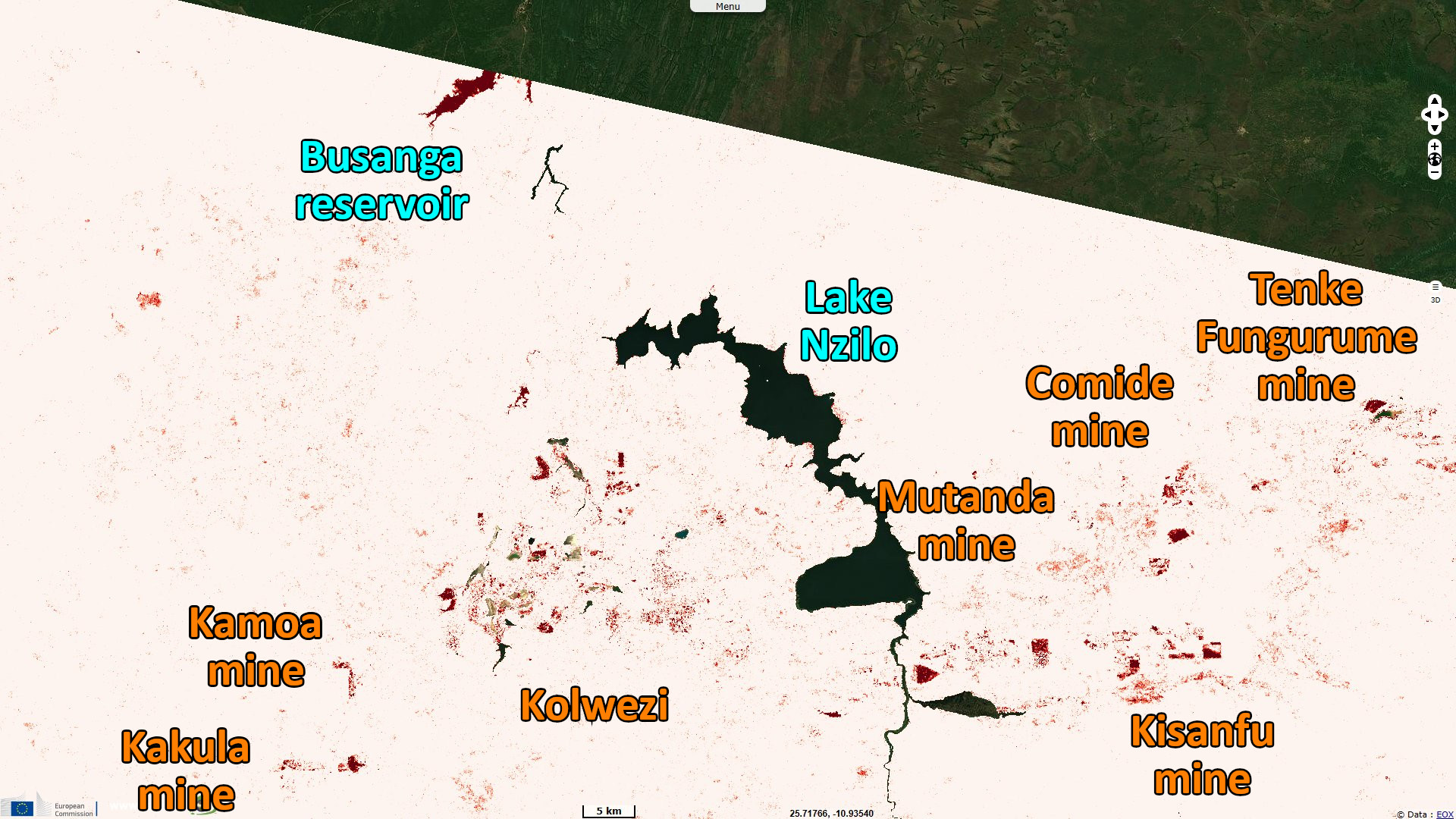Kamoa-Kakula mining complex, from bronze to silver medal in copper mining, Katangan Copperbelt, DRC
Landsat TM acquired on 02 June 1984 from 07:50:30 to 07:50:54 UTC
Sentinel-2 MSI acquired on 05 June 2016 at 08:16:12 UTC
Sentinel-1 CSAR IW acquired on 15 June 2016 at 03:55:35 UTC
Sentinel-1 CSAR IW acquired on 03 June 2023 at 03:56:16 UTC
Sentinel-2 MSI acquired on 04 June 2023 at 08:16:09 UTC
Sentinel-2 MSI acquired on 05 June 2016 at 08:16:12 UTC
Sentinel-1 CSAR IW acquired on 15 June 2016 at 03:55:35 UTC
Sentinel-1 CSAR IW acquired on 03 June 2023 at 03:56:16 UTC
Sentinel-2 MSI acquired on 04 June 2023 at 08:16:09 UTC
Keyword(s): Land, natural ressources, copper mine, green energy, DRC, Congo
The DRC is set to dethrone Peru as the world's second largest copper producer by 2026-2027, just behind Chile, the world's number one (with production of 5.36 million tonnes in 2022). These are the forecasts made by the Wood Mackenzie consultancy in a report on the ore published on 31 May.
The high ore grades mean that more copper can be extracted from a relatively small volume of rock, giving the African country a significant comparative advantage. The DRC also benefits from other mineral resources such as cobalt, gold and zinc.
Muriel Devey Malu-Malu published an article for Jeune Afrique in which she reminds the importance of this mining complex: One year after coming on stream, the Kamco mining project near Kolwezi is exceeding all expectations. It is set to become the world's third largest copper production complex by 2024. The Kamoa-Kakula concession, which covers the three operating licences of Kamoa Copper (Kamco), is huge. It covers an area of 400 km², 25 km west of Kolwezi in the southern Lualaba region. A lunar landscape? No, because the mining sites are separated from each other by shrubby savannahs that colour the horizon green.
According to Olivier Binyingo, Vice-President of Public Relations for Ivanhoe Mines in the DRC, the probable reserves of this copper-rich mega-complex are estimated at 233 million tonnes (Mt) of crude ore with a copper content of 4.46%, or 10.4 Mt of contained copper. A jackpot for Kamco, whose capital is held by the Canadian Ivanhoe Mines (39.6%), the Chinese Zijin Mining (39.6%), the British-Hong Kong Crystal River Global Ltd (0.8%) and the Congolese state (20%).
Marie-Pierre Olphand highlights the contribution of Kamoa-Kakula to the production of DRC: The mine could extract more than 800 000 tonnes of copper a year, according to estimates provided by the mining group. This would boost the country's copper production by 60%. A new windfall for the DRC, which will further consolidate its position as the continent's leading producer of the red metal, ahead of Zambia.
For this mine, as for the country's other deposits, the government will receive royalties based on the volume exported. Its 20% stake in the project will also be another source of revenue, depending on profits. China, which currently sucks in 40% of the world's copper, will be the main buyer of Congolese ore. This should come as no surprise, given the very high level of Chinese investment.
With Kamoa Kakula, the DRC should supply 2 to 3% of the world's copper. This will significantly increase supply at a time when demand is only growing under pressure from the search for energy sources that pollute the atmosphere less. "The driving force is decarbonisation, which requires a lot of cobalt, nickel and, above all, copper", explains the contributor to the Cyclope report, France's annual bible on raw materials. Ultimately, this new supply of Congolese red metal could help to bring prices down and influence the profitability of other projects.
The fact that the Democratic Republic of Congo has the second-largest copper mine in the world is not insignificant, says a mining consultant, who points out that the country is currently giving cobalt buyers cold sweats, as they seek to distance themselves from the poor image associated with the management of Congolese mining resources.
The company leading the consortium describes the environmental constraints it dealts with: "Despite this immense potential, the country faces challenges in taking full advantage of its growing position in global non-ferrous metals production. According to the Wood Mackenzie experts, transparent and responsible management of the mining industry is of paramount importance. They stressed the need to promote environmentally sustainable practices and to protect the rights of both workers and local communities."
"Kamoa-Kakula is powered by renewable hydro-electric energy and is expected to become the lowest emitter of greenhouse gases per unit of metal produced, as confirmed by the independent audit conducted in 2020 by Hatch Ltd, Mississauga, Canada. Kakula Mine will have the most favourable environmental footprint of any Tier 1 copper mine in the world. Kakula will also have a relatively small surface footprint. In fact, approximately 55% of the mine's tailings will be pumped back into the underground workings. Ivanhoe Mines is committed to achieving net-zero greenhouse gas emissions (Scope 1 and 2) at the Kamoa-Kakula copper mine."










